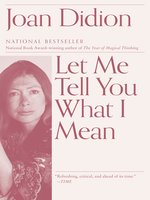-

November 1, 2020
A dozen pieces of nonfiction from the acclaimed novelist, memoirist, and screenwriter. In an appreciative introduction, New Yorker theater critic Hilton Als praises Didion as "a carver of words in the granite of the specific." Stylistic precision ("Grammar is a piano I play by ear," she writes) and the "energy and shimmer" of her prose are fully evident in this volume of previously uncollected pieces, written from 1968 to 2000. Although Didion portrays herself as a diffident, unconfident writer as a college student, she learned "a kind of ease with words" when working at Vogue, where she was assigned to write punchy, concise copy. The experience, she recalls, was "not unlike training with the Rockettes." Several pieces were originally published in magazines, and two were introductions: one, to a volume of photography by Robert Mapplethorpe; another, to a memoir by director--and Didion's friend--Tony Richardson. All reveal the author's shrewd, acerbic critical eye. In "Getting Serenity," she reports on a meeting of Gamblers Anonymous, where, she notes sardonically, one woman "adapted her mode of public address from analgesic commercials." William Randolph Hearst's "phantasmagoric barony," San Simeon, "seemed to confirm the boundless promise of the place we lived," but, she decided, was best admired from afar, like a fairy-tale castle, "floating fantastically." Didion's rejection from Stanford elicited an essay about college as consumption, and her skewering of consumption and artifice recur as themes--for example, in her observation of the ways women stage themselves for portrait photographs. Several particularly revealing essays focus on writing: "I write entirely to find out what I'm thinking," she famously admitted, a statement often misattributed to others. Writing, for her, is "the act of saying I, of imposing oneself upon other people, of saying listen to me, see it my way, change your mind. It's an aggressive, even a hostile act." As these pieces show, it's also an accomplished act of seduction. A slender, highly satisfying collection.
COPYRIGHT(2020) Kirkus Reviews, ALL RIGHTS RESERVED.
-

November 9, 2020
This wide-ranging essay collection from Didion (South and West: From a Notebook) showcases her strengths as a short form writer. Organized chronologically from 1968 to 2000, the pieces trace Didion’s development as an essayist and offer glimpses of late-20th-century social history. In 1968’s “Alicia and the Underground Press,” Didion writes of “tabloid-sized papers that respect the special interests of the young and the disaffiliated,” praising their ability to speak directly to their readers; “The Long-Distance Runner,” from 1993, is an ode to filmmaker Tony Richardson: “I never knew anyone who so loved to make things,” she writes; and “Everywoman.com,” from 2000, examines the “cultural meaning of Martha Stewart’s success” and the way she “branded herself not as Superwoman but as Everywoman.” As always, the writing is captivating—in the early “Getting Serenity,” she writes about attending a Gamblers Anonymous meeting (“I got out fast then, before anyone could say ‘serenity’ again, for it is a word I associate with death”) and finds just the right details to nail down the feeling of a bygone era—for example, the mix of “plastic hydrangeas” and cigarette smoke at the GA meeting. Didion fans new and old will be delighted.
-

November 1, 2020
In a 1968 essay contrasting mainstream media with the underground press, Didion writes, "I admire objectivity very much indeed, but I fail to see how it can be achieved if the reader does not understand the writer's particular bias." That's Didion in an essence, elegantly dismantling assumptions and stating discomfiting truths. In "Why I Write," another of the dozen arresting, mind-tuning, previously uncollected essays in this exhilarating and instructive gathering spanning several decades, she states that writing is "an aggressive, even a hostile act." It is also a voyage of discovery for Didion, conducted via meticulous observation and assiduous questioning of what she thinks and how her investigations make her feel. We see this at work in her responses to a reunion of the WWII 101st Airborne Division during the Vietnam War and a photo shoot with Nancy Reagan, and in profiles of Robert Mapplethorpe and Martha Stewart. Didion is both porous and steely, self-deprecating and in command. With a perceptive foreword by Hilton Als, who discerns the "uncanny" in Didion's exacting work, this an illuminating and inspiring addition to the influential Didion canon.
COPYRIGHT(2020) Booklist, ALL RIGHTS RESERVED.
-

January 1, 2021
Didion's latest book of essays is engrossing, memorable, and delightful. The pieces are not new, but newly collected, dating between 1968 and 2000, though they are remarkably consistent and relevant throughout. Subjects vary widely, from the posthumous publication of Ernest Hemingway's works and the complicated business personality of Martha Stewart, to visiting the Hearst Castle in San Simeon and attending photo shoots for Vogue. All are written with sincerity and with Didion's powerful sense of astute observation, as she describes her influences, worries, and occasionally fears. Readers can judge for themselves their own standout essay from the collection, but surely "Why I Write" will be a strong contender. Several pieces in this volume attend to the craft and purpose of writing, and in this one especially Didion candidly shows her devotion to writing and explains her own place and purpose as a writer. VERDICT This volume could be read in one sitting or one vignette at a time, as Didion's perceptive voice connects the essays beautifully, but each one can stand equally well on its own terms. For both fans of Didion and those new to her work entirely, this collection is an essential investment.--Sarah Schroeder, Univ. of Washington Bothell
Copyright 2021 Library Journal, LLC Used with permission.








